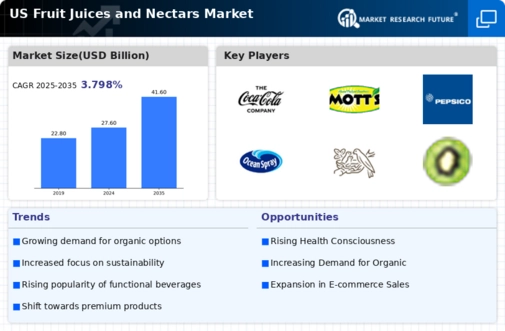Expansion of Distribution Channels
is benefiting from expanded distribution channels, which enhances product availability and accessibility. Retailers are increasingly diversifying their offerings by including fruit juices and nectars in various formats, such as online platforms and convenience stores. This trend is driven by the rise of e-commerce and changing consumer shopping habits. Data indicates that online sales of fruit juices have increased by 30% in the last year, highlighting the importance of digital channels. As a result, brands in the fruit juices-nectars market are investing in multi-channel strategies to reach a broader audience and improve their market penetration.
Rising Demand for Natural Ingredients
The fruit juices-nectars market is experiencing a notable shift towards natural and organic ingredients. Consumers are increasingly seeking products that are free from artificial additives and preservatives. This trend is driven by a growing awareness of health and wellness, with many individuals prioritizing clean label products. According to recent data, the organic fruit juice segment has seen a growth rate of approximately 15% annually, indicating a robust demand for natural offerings. As consumers become more discerning, brands in the fruit juices-nectars market are adapting their formulations to meet these preferences, thereby enhancing their market presence and competitiveness.
Growing Popularity of On-the-Go Consumption
is adapting to consumers' fast-paced lifestyles, leading to an increase in on-the-go packaging solutions. As more individuals seek convenient and portable beverage options, brands are responding by offering single-serve packages and ready-to-drink formats. This shift is particularly evident among younger demographics, who prioritize convenience in their purchasing decisions. Recent statistics indicate that single-serve fruit juice sales have risen by 20% over the past year, underscoring the importance of accessibility in the market. Consequently, companies in the fruit juices-nectars market are focusing on innovative packaging designs to capture this growing segment.
Increased Consumption of Functional Beverages
The fruit juices-nectars market is witnessing a surge in the popularity of functional beverages, which are perceived to offer health benefits beyond basic nutrition. This trend is largely influenced by consumers' desire for products that support their overall well-being. Functional fruit juices, enriched with vitamins, minerals, and probiotics, are gaining traction. Market data suggests that the functional beverage segment is projected to grow by 10% annually, reflecting a shift in consumer preferences. As a result, manufacturers in the fruit juices-nectars market are innovating to create products that cater to this demand, thereby expanding their product lines and enhancing consumer engagement.
Emphasis on Sustainability and Ethical Sourcing
The fruit juices-nectars market is increasingly influenced by consumer demand for sustainability and ethical sourcing practices. As environmental concerns grow, consumers are more inclined to support brands that prioritize eco-friendly practices and responsible sourcing of ingredients. This trend is reflected in the rising popularity of brands that utilize sustainable farming methods and recyclable packaging. Market Research Future indicates that products marketed as sustainable can command a price premium of up to 15%, suggesting a willingness among consumers to invest in environmentally conscious options. Consequently, companies in the fruit juices-nectars market are adopting sustainable practices to align with consumer values and enhance brand loyalty.




















Leave a Comment